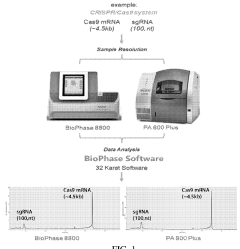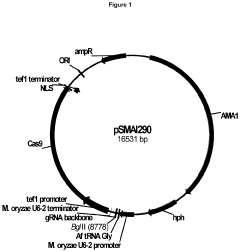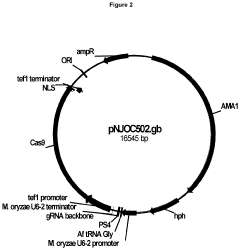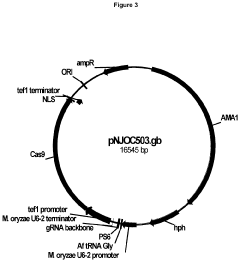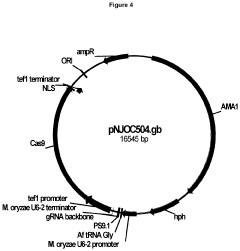Gel Electrophoresis and CRISPR: Synergistic Advances
JUN 30, 20259 MIN READ
Generate Your Research Report Instantly with AI Agent
Patsnap Eureka helps you evaluate technical feasibility & market potential.
Gel-CRISPR Synergy: Background and Objectives
Gel electrophoresis and CRISPR (Clustered Regularly Interspaced Short Palindromic Repeats) are two groundbreaking technologies that have revolutionized molecular biology and genetic engineering. The synergistic advances of these techniques have opened up new possibilities for precise genetic manipulation and analysis.
Gel electrophoresis, developed in the 1960s, has been a cornerstone technique in molecular biology for separating and analyzing DNA, RNA, and proteins based on their size and charge. This method has been instrumental in various applications, including DNA sequencing, genetic fingerprinting, and disease diagnosis.
CRISPR, on the other hand, is a more recent innovation that has taken the scientific world by storm since its discovery in the early 2000s. Originally identified as a bacterial defense mechanism against viral infections, CRISPR has been adapted into a powerful gene-editing tool that allows researchers to make precise modifications to DNA sequences in living organisms.
The convergence of these two technologies has led to significant advancements in genomic research and biotechnology. By combining the analytical power of gel electrophoresis with the precision of CRISPR-based gene editing, researchers can now achieve unprecedented levels of accuracy and efficiency in genetic manipulation and analysis.
The primary objective of researching the synergistic advances of gel electrophoresis and CRISPR is to develop more sophisticated and effective methods for genetic engineering and molecular diagnostics. This includes improving the accuracy of gene editing, enhancing the detection and characterization of genetic modifications, and streamlining the process of genetic analysis.
One of the key goals is to optimize the use of gel electrophoresis in verifying and analyzing CRISPR-induced genetic modifications. This involves developing new electrophoresis techniques that can better resolve small genetic changes and detect off-target effects of CRISPR editing.
Another important objective is to explore how CRISPR technology can be used to enhance gel electrophoresis methods. This may include developing CRISPR-based approaches for labeling specific DNA sequences or creating novel DNA markers that can improve the resolution and sensitivity of gel electrophoresis.
Furthermore, researchers aim to integrate these technologies to create more efficient and high-throughput methods for genetic screening and analysis. This could lead to the development of new diagnostic tools for genetic disorders, improved methods for studying gene function, and more effective strategies for genetic engineering in various fields, including medicine, agriculture, and biotechnology.
Gel electrophoresis, developed in the 1960s, has been a cornerstone technique in molecular biology for separating and analyzing DNA, RNA, and proteins based on their size and charge. This method has been instrumental in various applications, including DNA sequencing, genetic fingerprinting, and disease diagnosis.
CRISPR, on the other hand, is a more recent innovation that has taken the scientific world by storm since its discovery in the early 2000s. Originally identified as a bacterial defense mechanism against viral infections, CRISPR has been adapted into a powerful gene-editing tool that allows researchers to make precise modifications to DNA sequences in living organisms.
The convergence of these two technologies has led to significant advancements in genomic research and biotechnology. By combining the analytical power of gel electrophoresis with the precision of CRISPR-based gene editing, researchers can now achieve unprecedented levels of accuracy and efficiency in genetic manipulation and analysis.
The primary objective of researching the synergistic advances of gel electrophoresis and CRISPR is to develop more sophisticated and effective methods for genetic engineering and molecular diagnostics. This includes improving the accuracy of gene editing, enhancing the detection and characterization of genetic modifications, and streamlining the process of genetic analysis.
One of the key goals is to optimize the use of gel electrophoresis in verifying and analyzing CRISPR-induced genetic modifications. This involves developing new electrophoresis techniques that can better resolve small genetic changes and detect off-target effects of CRISPR editing.
Another important objective is to explore how CRISPR technology can be used to enhance gel electrophoresis methods. This may include developing CRISPR-based approaches for labeling specific DNA sequences or creating novel DNA markers that can improve the resolution and sensitivity of gel electrophoresis.
Furthermore, researchers aim to integrate these technologies to create more efficient and high-throughput methods for genetic screening and analysis. This could lead to the development of new diagnostic tools for genetic disorders, improved methods for studying gene function, and more effective strategies for genetic engineering in various fields, including medicine, agriculture, and biotechnology.
Market Analysis for Integrated Gel-CRISPR Technologies
The integration of Gel Electrophoresis and CRISPR technologies has created a burgeoning market with significant growth potential. This synergy addresses critical needs in genomic research, diagnostics, and therapeutic development, driving demand across various sectors. The global market for integrated Gel-CRISPR technologies is expected to experience robust growth in the coming years, fueled by advancements in precision medicine and personalized healthcare.
The pharmaceutical and biotechnology industries represent the largest market segments for integrated Gel-CRISPR technologies. These sectors leverage the combined power of gel electrophoresis and CRISPR for drug discovery, target validation, and the development of gene therapies. The increasing focus on rare genetic disorders and oncology has further amplified the demand for these integrated technologies.
Academic and research institutions form another substantial market segment, utilizing Gel-CRISPR technologies for fundamental genomic research, functional genomics studies, and the exploration of gene editing applications. The growing emphasis on CRISPR-based screening methods has led to increased adoption in this sector.
The diagnostics market is emerging as a rapidly growing segment for integrated Gel-CRISPR technologies. The ability to combine precise gene editing with efficient DNA separation and analysis has opened new avenues for developing highly sensitive and specific diagnostic tools. This is particularly relevant in the context of infectious diseases, genetic disorders, and cancer diagnostics.
Geographically, North America currently dominates the market for integrated Gel-CRISPR technologies, owing to its robust research infrastructure, significant investments in genomics, and the presence of key industry players. However, the Asia-Pacific region is expected to witness the fastest growth rate in the coming years, driven by increasing research funding, expanding biotechnology sectors in countries like China and India, and growing awareness of precision medicine approaches.
The agriculture and food industry represents an emerging market for Gel-CRISPR technologies, with applications in crop improvement, livestock breeding, and food safety testing. As regulations surrounding gene-edited crops evolve, this sector is poised for significant growth.
Key market drivers include the increasing prevalence of genetic disorders, rising cancer incidence, growing demand for personalized medicine, and advancements in CRISPR technology that enhance its specificity and efficiency. Additionally, the COVID-19 pandemic has highlighted the importance of rapid diagnostic tools and accelerated vaccine development, further boosting the market for integrated Gel-CRISPR technologies.
However, market growth faces challenges such as ethical concerns surrounding gene editing, regulatory hurdles, and the high cost of equipment and reagents. Overcoming these barriers will be crucial for realizing the full market potential of integrated Gel-CRISPR technologies.
The pharmaceutical and biotechnology industries represent the largest market segments for integrated Gel-CRISPR technologies. These sectors leverage the combined power of gel electrophoresis and CRISPR for drug discovery, target validation, and the development of gene therapies. The increasing focus on rare genetic disorders and oncology has further amplified the demand for these integrated technologies.
Academic and research institutions form another substantial market segment, utilizing Gel-CRISPR technologies for fundamental genomic research, functional genomics studies, and the exploration of gene editing applications. The growing emphasis on CRISPR-based screening methods has led to increased adoption in this sector.
The diagnostics market is emerging as a rapidly growing segment for integrated Gel-CRISPR technologies. The ability to combine precise gene editing with efficient DNA separation and analysis has opened new avenues for developing highly sensitive and specific diagnostic tools. This is particularly relevant in the context of infectious diseases, genetic disorders, and cancer diagnostics.
Geographically, North America currently dominates the market for integrated Gel-CRISPR technologies, owing to its robust research infrastructure, significant investments in genomics, and the presence of key industry players. However, the Asia-Pacific region is expected to witness the fastest growth rate in the coming years, driven by increasing research funding, expanding biotechnology sectors in countries like China and India, and growing awareness of precision medicine approaches.
The agriculture and food industry represents an emerging market for Gel-CRISPR technologies, with applications in crop improvement, livestock breeding, and food safety testing. As regulations surrounding gene-edited crops evolve, this sector is poised for significant growth.
Key market drivers include the increasing prevalence of genetic disorders, rising cancer incidence, growing demand for personalized medicine, and advancements in CRISPR technology that enhance its specificity and efficiency. Additionally, the COVID-19 pandemic has highlighted the importance of rapid diagnostic tools and accelerated vaccine development, further boosting the market for integrated Gel-CRISPR technologies.
However, market growth faces challenges such as ethical concerns surrounding gene editing, regulatory hurdles, and the high cost of equipment and reagents. Overcoming these barriers will be crucial for realizing the full market potential of integrated Gel-CRISPR technologies.
Current Challenges in Gel Electrophoresis and CRISPR Integration
The integration of Gel Electrophoresis and CRISPR technologies presents several significant challenges that researchers and developers must address to fully harness their synergistic potential. One of the primary obstacles is the optimization of gel electrophoresis conditions for CRISPR-edited DNA fragments. The diverse range of CRISPR-induced mutations, including insertions, deletions, and substitutions, requires careful adjustment of gel composition, voltage, and running time to achieve optimal separation and resolution.
Another challenge lies in the detection and quantification of CRISPR-induced modifications using gel electrophoresis. Traditional methods may lack the sensitivity to distinguish between small genetic alterations, necessitating the development of more advanced detection techniques. This includes the integration of fluorescent markers or the use of high-resolution gel systems to enhance the visualization of subtle genetic changes.
The scalability of combined Gel Electrophoresis and CRISPR workflows poses a significant hurdle, particularly in high-throughput applications. Researchers must develop automated systems that can efficiently process large numbers of samples while maintaining accuracy and reproducibility. This requires advancements in both gel electrophoresis equipment and CRISPR editing protocols to ensure seamless integration and streamlined workflows.
Furthermore, the analysis and interpretation of gel electrophoresis results for CRISPR-edited samples present challenges in data processing and standardization. The development of robust software tools and algorithms capable of accurately analyzing complex banding patterns and quantifying editing efficiencies is crucial for advancing the field.
Another critical challenge is the adaptation of gel electrophoresis techniques for the analysis of CRISPR-edited RNA. As CRISPR technology expands into RNA editing applications, researchers must overcome the inherent instability of RNA molecules and develop specialized gel systems and running conditions to effectively separate and analyze RNA fragments.
The miniaturization of gel electrophoresis systems for point-of-care CRISPR applications represents an emerging challenge. Developing compact, portable devices that can perform rapid and accurate analysis of CRISPR-edited samples outside of traditional laboratory settings is essential for expanding the reach and impact of these technologies.
Lastly, ensuring the compatibility of gel electrophoresis methods with emerging CRISPR variants and delivery systems poses an ongoing challenge. As new CRISPR tools and techniques continue to emerge, researchers must continuously adapt and optimize gel electrophoresis protocols to accommodate these advancements and maintain their effectiveness in analyzing CRISPR-edited samples.
Another challenge lies in the detection and quantification of CRISPR-induced modifications using gel electrophoresis. Traditional methods may lack the sensitivity to distinguish between small genetic alterations, necessitating the development of more advanced detection techniques. This includes the integration of fluorescent markers or the use of high-resolution gel systems to enhance the visualization of subtle genetic changes.
The scalability of combined Gel Electrophoresis and CRISPR workflows poses a significant hurdle, particularly in high-throughput applications. Researchers must develop automated systems that can efficiently process large numbers of samples while maintaining accuracy and reproducibility. This requires advancements in both gel electrophoresis equipment and CRISPR editing protocols to ensure seamless integration and streamlined workflows.
Furthermore, the analysis and interpretation of gel electrophoresis results for CRISPR-edited samples present challenges in data processing and standardization. The development of robust software tools and algorithms capable of accurately analyzing complex banding patterns and quantifying editing efficiencies is crucial for advancing the field.
Another critical challenge is the adaptation of gel electrophoresis techniques for the analysis of CRISPR-edited RNA. As CRISPR technology expands into RNA editing applications, researchers must overcome the inherent instability of RNA molecules and develop specialized gel systems and running conditions to effectively separate and analyze RNA fragments.
The miniaturization of gel electrophoresis systems for point-of-care CRISPR applications represents an emerging challenge. Developing compact, portable devices that can perform rapid and accurate analysis of CRISPR-edited samples outside of traditional laboratory settings is essential for expanding the reach and impact of these technologies.
Lastly, ensuring the compatibility of gel electrophoresis methods with emerging CRISPR variants and delivery systems poses an ongoing challenge. As new CRISPR tools and techniques continue to emerge, researchers must continuously adapt and optimize gel electrophoresis protocols to accommodate these advancements and maintain their effectiveness in analyzing CRISPR-edited samples.
Existing Gel-CRISPR Synergistic Approaches
01 Gel electrophoresis techniques for DNA analysis
Various gel electrophoresis techniques are used for DNA analysis, including separation and visualization of DNA fragments. These methods can be applied to analyze CRISPR-edited DNA samples, allowing researchers to detect and characterize genetic modifications. Improvements in gel electrophoresis systems focus on enhancing resolution, speed, and efficiency of DNA separation.- Gel electrophoresis techniques for DNA analysis: Various gel electrophoresis techniques are used for DNA analysis, including separation and visualization of DNA fragments. These methods can be applied to analyze CRISPR-edited DNA samples, allowing researchers to detect and characterize genetic modifications. Improvements in gel electrophoresis systems focus on enhancing resolution, speed, and efficiency of DNA separation.
- Integration of CRISPR and gel electrophoresis in diagnostic applications: Combining CRISPR technology with gel electrophoresis enables the development of novel diagnostic tools. These integrated systems can detect specific genetic sequences, mutations, or pathogens with high sensitivity and specificity. Such applications are particularly useful in medical diagnostics, environmental monitoring, and food safety testing.
- Microfluidic devices for CRISPR and electrophoresis: Microfluidic devices are being developed to combine CRISPR-based gene editing or detection with electrophoretic separation. These miniaturized systems offer advantages such as reduced sample volume, faster analysis times, and potential for automation. They are particularly useful for point-of-care diagnostics and high-throughput screening applications.
- Electrophoresis methods for CRISPR product analysis: Specialized electrophoresis methods are developed to analyze CRISPR-Cas9 editing outcomes. These techniques can detect indels, large deletions, or insertions resulting from CRISPR-mediated genome editing. Improvements focus on increasing sensitivity and accuracy in detecting various types of genetic modifications.
- Capillary electrophoresis for CRISPR applications: Capillary electrophoresis is utilized in CRISPR-related research for high-resolution separation of DNA fragments. This technique offers advantages such as rapid analysis, small sample requirements, and potential for automation. It can be applied to analyze CRISPR guide RNAs, detect off-target effects, or characterize CRISPR-edited DNA sequences.
02 Integration of CRISPR and gel electrophoresis in diagnostic applications
Combining CRISPR technology with gel electrophoresis enables the development of novel diagnostic tools. These integrated systems can detect specific genetic sequences, mutations, or pathogens with high sensitivity and specificity. Such applications are particularly useful in medical diagnostics, environmental monitoring, and food safety testing.Expand Specific Solutions03 Microfluidic devices for CRISPR and electrophoresis
Microfluidic devices are being developed to combine CRISPR-based gene editing or detection with electrophoretic separation. These miniaturized systems offer advantages such as reduced sample volume, faster analysis times, and potential for automation. They are particularly useful for point-of-care diagnostics and high-throughput screening applications.Expand Specific Solutions04 Electrophoresis methods for CRISPR product analysis
Specialized electrophoresis methods are developed to analyze CRISPR-Cas9 editing outcomes. These techniques can detect indels, large deletions, or insertions resulting from CRISPR-mediated genome editing. Improvements in resolution and sensitivity allow for more accurate quantification of editing efficiency and characterization of off-target effects.Expand Specific Solutions05 Capillary electrophoresis for CRISPR applications
Capillary electrophoresis techniques are adapted for CRISPR-related applications, offering high-resolution separation of DNA fragments. These methods can be used to analyze guide RNAs, Cas9 proteins, or CRISPR-edited DNA samples. Advancements in capillary electrophoresis systems focus on improving sensitivity, automation, and integration with other analytical techniques.Expand Specific Solutions
Key Players in Gel-CRISPR Synergistic Research
The synergistic advances of Gel Electrophoresis and CRISPR are in a rapidly evolving phase, characterized by significant market growth and technological maturation. This field is at the intersection of genomics and biotechnology, with an estimated global market size exceeding $10 billion. Companies like Life Technologies Corp. and Bio-Rad Laboratories are leading the charge in developing advanced gel electrophoresis systems, while Editas Medicine and CRISPR pioneers are pushing the boundaries of gene editing technologies. Academic institutions such as MIT and Jilin University are contributing groundbreaking research, fostering collaborations between industry and academia. The integration of these technologies is accelerating, promising transformative applications in personalized medicine, agriculture, and biotechnology.
Life Technologies Corp.
Technical Solution: Life Technologies has developed a comprehensive platform that integrates advanced gel electrophoresis techniques with CRISPR gene editing technology. Their system utilizes pulsed-field gel electrophoresis (PFGE) optimized for the separation and analysis of large DNA fragments resulting from CRISPR-mediated genomic rearrangements[13]. They have also implemented a novel "CRISPR-capture" electrophoresis method, which uses sequence-specific probes to selectively isolate and analyze CRISPR-edited DNA fragments during electrophoresis[14]. Additionally, Life Technologies has developed a suite of fluorescent dyes and imaging systems specifically designed for visualizing CRISPR-induced DNA modifications in electrophoresis gels, enabling highly sensitive detection of editing events[15].
Strengths: Capability to analyze large genomic rearrangements, high sensitivity in detecting CRISPR edits, and specialized reagents for CRISPR applications. Weaknesses: Potentially complex protocols and requirement for specialized equipment.
F. Hoffmann-La Roche Ltd.
Technical Solution: Roche has developed an integrated platform that combines their expertise in gel electrophoresis systems with CRISPR gene editing technology. Their approach utilizes high-performance capillary gel electrophoresis to analyze CRISPR-edited DNA with exceptional resolution[10]. Roche's system incorporates automated sample preparation and analysis, allowing for high-throughput screening of CRISPR edits. They have also developed specialized fluorescent probes that can detect specific CRISPR-induced modifications during electrophoresis, enabling multiplexed analysis of multiple genetic targets simultaneously[11]. Furthermore, Roche has implemented a cloud-based data analysis platform that integrates electrophoresis results with genomic databases to provide comprehensive insights into CRISPR editing outcomes[12].
Strengths: High-throughput capability, multiplexed analysis, and integrated data management. Weaknesses: Potentially high cost and reliance on proprietary consumables.
Innovative Gel-CRISPR Integration Techniques
Capillary electrophoresis methods for the simultaneous separation of nucleic acids of varying lengths
PatentWO2023187591A1
Innovation
- A capillary electrophoresis method that allows for the simultaneous separation and analysis of nucleic acids of different sizes, including sgRNA and Cas9 mRNA, using a polymer matrix in a CE capillary without dilution, employing hydrodynamic injection and fluorescent dyes for high-resolution detection.
Genome Editing by Guided Endonuclease and Single-stranded Oligonucleotide
PatentInactiveUS20220010305A1
Innovation
- The use of longer single-stranded oligonucleotides as repair templates in conjunction with a polynucleotide-guided endonuclease, such as MAD7 or Cas9, to introduce desired nucleotide modifications into microorganism genomes, achieving high efficiency even at greater distances from the cut site by directing DNA repair.
Regulatory Considerations for Gel-CRISPR Technologies
The regulatory landscape for Gel-CRISPR technologies is complex and evolving, reflecting the rapid advancements in this field. As these technologies combine gel electrophoresis and CRISPR gene editing, they fall under the purview of multiple regulatory bodies, each with its own set of guidelines and requirements.
In the United States, the Food and Drug Administration (FDA) plays a central role in regulating Gel-CRISPR technologies, particularly when they are intended for clinical applications. The FDA's approach to these technologies is multifaceted, considering them under the broader umbrella of gene therapy products. The agency has established specific guidance documents for gene therapy, which include considerations for CRISPR-based technologies.
The Environmental Protection Agency (EPA) also has a stake in the regulation of Gel-CRISPR technologies, especially when considering potential environmental impacts. This includes assessing the risks associated with the release of genetically modified organisms created using these technologies.
Internationally, regulatory frameworks vary significantly. The European Medicines Agency (EMA) has developed guidelines for gene therapy medicinal products, which encompass Gel-CRISPR technologies. These guidelines emphasize the need for comprehensive risk assessments and long-term follow-up studies.
In Asia, countries like China and Japan have been proactive in developing regulatory frameworks for gene editing technologies. China, in particular, has implemented stringent regulations following controversial human embryo gene editing experiments.
A key regulatory consideration for Gel-CRISPR technologies is the potential for off-target effects. Regulatory bodies worldwide are increasingly requiring robust data on the specificity and efficiency of gene editing techniques, including those that incorporate gel electrophoresis for improved precision.
Ethical considerations also play a significant role in the regulatory landscape. Many countries have established ethics committees or advisory boards to guide the development and application of gene editing technologies, including Gel-CRISPR methods.
As the field continues to advance, regulatory bodies are faced with the challenge of balancing innovation with safety and ethical concerns. This has led to calls for international harmonization of regulatory approaches to ensure consistent standards across borders while fostering scientific progress.
In the United States, the Food and Drug Administration (FDA) plays a central role in regulating Gel-CRISPR technologies, particularly when they are intended for clinical applications. The FDA's approach to these technologies is multifaceted, considering them under the broader umbrella of gene therapy products. The agency has established specific guidance documents for gene therapy, which include considerations for CRISPR-based technologies.
The Environmental Protection Agency (EPA) also has a stake in the regulation of Gel-CRISPR technologies, especially when considering potential environmental impacts. This includes assessing the risks associated with the release of genetically modified organisms created using these technologies.
Internationally, regulatory frameworks vary significantly. The European Medicines Agency (EMA) has developed guidelines for gene therapy medicinal products, which encompass Gel-CRISPR technologies. These guidelines emphasize the need for comprehensive risk assessments and long-term follow-up studies.
In Asia, countries like China and Japan have been proactive in developing regulatory frameworks for gene editing technologies. China, in particular, has implemented stringent regulations following controversial human embryo gene editing experiments.
A key regulatory consideration for Gel-CRISPR technologies is the potential for off-target effects. Regulatory bodies worldwide are increasingly requiring robust data on the specificity and efficiency of gene editing techniques, including those that incorporate gel electrophoresis for improved precision.
Ethical considerations also play a significant role in the regulatory landscape. Many countries have established ethics committees or advisory boards to guide the development and application of gene editing technologies, including Gel-CRISPR methods.
As the field continues to advance, regulatory bodies are faced with the challenge of balancing innovation with safety and ethical concerns. This has led to calls for international harmonization of regulatory approaches to ensure consistent standards across borders while fostering scientific progress.
Ethical Implications of Gel-CRISPR Advancements
The synergistic advances of Gel Electrophoresis and CRISPR technologies have opened up unprecedented possibilities in genetic research and manipulation. However, these advancements also raise significant ethical concerns that must be carefully considered and addressed.
One of the primary ethical implications is the potential for unintended consequences in genetic modifications. As Gel-CRISPR techniques become more precise and efficient, there is an increased risk of off-target effects that could lead to unforeseen genetic alterations. This raises questions about the long-term impact on individuals and ecosystems, particularly when applied to germline editing.
Privacy and consent issues also come to the forefront with these advancements. The ability to analyze and manipulate genetic material with greater accuracy may lead to concerns about genetic discrimination and the protection of sensitive genetic information. Ensuring proper informed consent and safeguarding genetic data become paramount ethical considerations.
The accessibility of Gel-CRISPR technologies raises questions about equitable distribution and potential misuse. As these tools become more widely available, there is a risk of creating genetic disparities between those who can afford genetic enhancements and those who cannot. This could exacerbate existing social inequalities and raise concerns about genetic determinism.
Ethical debates surrounding human enhancement and designer babies are likely to intensify with Gel-CRISPR advancements. The ability to select and modify genetic traits more precisely may lead to societal pressures for genetic "perfection," raising questions about the value of human diversity and the rights of individuals with genetic differences.
Environmental and ecological concerns also arise from the potential use of Gel-CRISPR technologies in modifying organisms for release into the wild. The ability to create gene drives or genetically modified organisms with enhanced traits could have far-reaching and potentially irreversible impacts on ecosystems and biodiversity.
The rapid pace of Gel-CRISPR advancements may outstrip existing regulatory frameworks and ethical guidelines. This creates a pressing need for international cooperation to establish comprehensive and flexible ethical standards that can keep pace with technological progress while ensuring responsible research and application.
Addressing these ethical implications requires ongoing dialogue between scientists, ethicists, policymakers, and the public. Developing robust ethical frameworks, enhancing public understanding of the technology, and fostering transparent decision-making processes will be crucial in navigating the complex ethical landscape of Gel-CRISPR advancements.
One of the primary ethical implications is the potential for unintended consequences in genetic modifications. As Gel-CRISPR techniques become more precise and efficient, there is an increased risk of off-target effects that could lead to unforeseen genetic alterations. This raises questions about the long-term impact on individuals and ecosystems, particularly when applied to germline editing.
Privacy and consent issues also come to the forefront with these advancements. The ability to analyze and manipulate genetic material with greater accuracy may lead to concerns about genetic discrimination and the protection of sensitive genetic information. Ensuring proper informed consent and safeguarding genetic data become paramount ethical considerations.
The accessibility of Gel-CRISPR technologies raises questions about equitable distribution and potential misuse. As these tools become more widely available, there is a risk of creating genetic disparities between those who can afford genetic enhancements and those who cannot. This could exacerbate existing social inequalities and raise concerns about genetic determinism.
Ethical debates surrounding human enhancement and designer babies are likely to intensify with Gel-CRISPR advancements. The ability to select and modify genetic traits more precisely may lead to societal pressures for genetic "perfection," raising questions about the value of human diversity and the rights of individuals with genetic differences.
Environmental and ecological concerns also arise from the potential use of Gel-CRISPR technologies in modifying organisms for release into the wild. The ability to create gene drives or genetically modified organisms with enhanced traits could have far-reaching and potentially irreversible impacts on ecosystems and biodiversity.
The rapid pace of Gel-CRISPR advancements may outstrip existing regulatory frameworks and ethical guidelines. This creates a pressing need for international cooperation to establish comprehensive and flexible ethical standards that can keep pace with technological progress while ensuring responsible research and application.
Addressing these ethical implications requires ongoing dialogue between scientists, ethicists, policymakers, and the public. Developing robust ethical frameworks, enhancing public understanding of the technology, and fostering transparent decision-making processes will be crucial in navigating the complex ethical landscape of Gel-CRISPR advancements.
Unlock deeper insights with Patsnap Eureka Quick Research — get a full tech report to explore trends and direct your research. Try now!
Generate Your Research Report Instantly with AI Agent
Supercharge your innovation with Patsnap Eureka AI Agent Platform!



